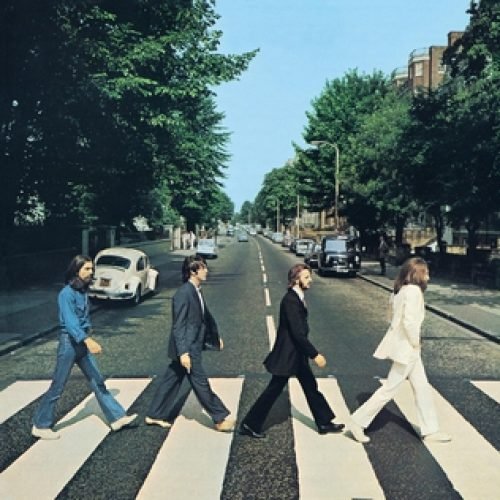Released on September 26, 1969, “Abbey Road” is not merely another entry in The Beatles‘ prolific catalog, but a profound encapsulation of their artistic maturity and their collaborative spirit nearing its end. This album arrives as their penultimate studio release, following the tumultuous sessions for the “White Album” and the fraught recordings of what would become “Let It Be.” By this point, the dynamics within The Beatles had changed significantly; yet, “Abbey Road” stands as a testament to their undiminished capacity for innovation and synergy.
In “Abbey Road,” The Beatles did not so much depart from their earlier experimental and eclectic sounds but rather refined them to an unprecedented degree of sophistication. The album is notable for its progressive rock elements, sumptuous harmonies, and intricate production techniques. It embodies a deliberate effort to return to a more collaborative approach to recording, albeit within the framework of their evolving individual artistic identities. George Martin, their producer, once again took a more active role, helping to orchestrate what many consider to be one of the band’s most sonically exquisite works.
Artistic Intentions
Artistically, “Abbey Road” was conceived with a keen awareness of the band’s tumult and the changing cultural landscapes of the late 1960s. It was both a nod to their earlier, more innocent pop songs and a bold stride into the complexities of their later years. The Beatles aimed to create something enduring and innovative — a seamless blend of rock, pop, and classical elements that pushed the boundaries of studio possibilities. This is perhaps best exemplified by the medley on Side Two, a continuous piece that showcases their creative fluidity and mastery of the album format. This ambitious suite of interconnected songs suggests a band still very much in love with the art of musical exploration and expression, despite the fractures within.
Sonic Exploration
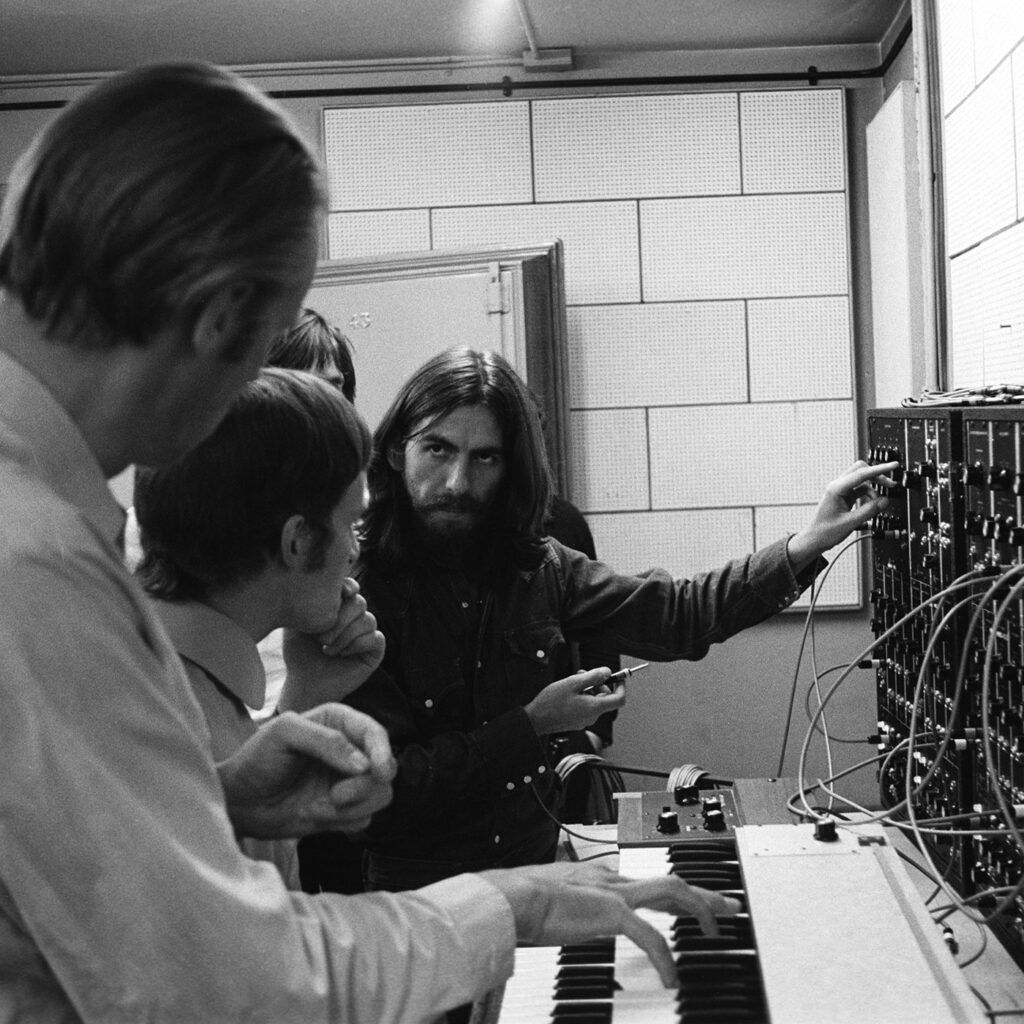
“Abbey Road” stands as a pinnacle of production quality within The Beatles’ discography, benefiting immensely from the advanced techniques and equipment available at Abbey Road Studios. The production under George Martin’s meticulous guidance is crisp, clear, and layered, allowing each instrument and vocal line to shine without compromising the complexity of the soundscapes. This clarity is a key component of the album’s enduring appeal, as it serves to enhance the innovative musical ideas and the emotional depth of the tracks. The use of the then-new solid-state mixing desk and eight-track recording technology gave “Abbey Road” a polished finish that was cutting-edge at the time, moving away from the lo-fi, gritty sound of some of their earlier work. The superior production quality helps to articulate the album’s themes of closure and transition, providing a sonic clarity that mirrors the band’s desire for a definitive final statement.
Musical Arrangements
The musical arrangements on “Abbey Road” are both complex and beautifully orchestrated, showcasing The Beatles’ evolved understanding of musical texture and form. The album features a rich tapestry of sounds, from the lush strings in “Something” to the playful synthesisers in “Here Comes the Sun.” The vocal arrangements are particularly noteworthy, with harmonies that are intricate yet seamless, exemplifying the group’s unmatched vocal chemistry. The standout is undoubtedly the Side Two medley, a bold experiment in connectivity and musical continuity. Songs flow into one another with an ease that belies the intricate structuring, each piece complementing the next to create a cohesive narrative flow. This medley, combining various musical motifs and themes into a single unified piece, represents a high point in The Beatles’ creative collaboration.
Genre Elements
“Abbey Road” traverses multiple musical landscapes, touching on genres like hard rock, pop, blues, and progressive rock, while also incorporating elements of classical music and avant-garde. Songs like “Come Together” offer a blend of rock and blues with an infectious rhythm that makes it timeless, whereas “Oh! Darling” showcases a more traditional rock and roll vibe reminiscent of the 1950s. Meanwhile, “Because” is ethereal and almost Baroque in its use of harpsichord-like sounds and layered vocals, drawing clear lines to classical influences. The genre-blending is both masterful and subtle, providing a rich, varied listening experience that stays cohesive under the album’s overarching aesthetic. This eclectic mix not only highlights The Beatles’ versatility but also their ability to integrate diverse musical styles into a unified artistic vision. “Abbey Road” is a testament to their ability to push genre boundaries and redefine what popular music could be, all while maintaining a distinct and powerful thematic coherence.
Lyrical Analysis

The lyrical content of “Abbey Road” is rich with themes of love, finality, reflection, and unity, weaving a complex tapestry that mirrors the band’s own concluding chapter. These themes are articulated through lyrics that range from the deeply personal to the whimsically abstract. For instance, George Harrison’s “Something” and “Here Comes the Sun” are imbued with love and optimism, using simple yet profound language to convey deep emotional truths. In contrast, John Lennon’s “Come Together” employs surreal and cryptic imagery, challenging listeners to find meaning beneath the playful surface.
A recurring motif in the album is the passage of time and the changes it brings, which is poignantly explored in “Golden Slumbers/Carry That Weight/The End” medley. This suite of songs reflects on the burdens of fame and the bittersweet nature of its inevitable conclusion, suggesting both a personal and professional awareness of The Beatles’ impending dissolution. The lyrics in “The End” — “And in the end, the love you take is equal to the love you make” — serve as a final, resonant statement on the legacy and mutual reciprocity of their career.
Lyrical Depth
The lyrics throughout “Abbey Road” demonstrate a maturity and poetic sophistication that mark the culmination of The Beatles’ lyrical evolution. The songs oscillate between straightforward, narrative-driven approaches and more abstract, metaphorical lyricism. Harrison’s contributions, for instance, show a marked depth, mixing direct emotional expression with a more contemplative, philosophical bent. Lennon’s and McCartney’s lyrics, while occasionally playful, also convey a deeper sense of introspection and existential inquiry, as seen in tracks like “Come Together” and “Oh! Darling.”
The poetic nature of these lyrics often leaves room for multiple interpretations, inviting listeners to find their own meanings within the universal themes of love, change, and farewell. This openness not only enhances the songs’ emotional layers but also broadens their appeal, allowing the album to resonate with diverse audiences across generations.
Emotional Impact
The emotional impact of “Abbey Road” is profound, driven by its lyrical content, which ranges from uplifting to melancholic. The optimism of “Here Comes the Sun” offers a soothing counterbalance to the somber undertones of “Because” and the earnest vulnerability of “Something.” The album’s conclusion, with its poignant medley, encourages a reflective journey through the emotions associated with endings and new beginnings.
The way the lyrics interact with the music amplifies their emotional power. The climactic sequence of “Golden Slumbers” into “The End” evokes a palpable sense of finality and catharsis, inviting listeners to share in the intimate, emotional release of the band members themselves. In this way, “Abbey Road” does not merely represent a collection of songs but a shared emotional experience that continues to evoke empathy, joy, sadness, and contemplation among its listeners. The lyrical prowess of the album ensures that its impact is not only deeply felt but also enduring, securing its place as a timeless piece of art in the annals of music history.
Cohesion and Flow
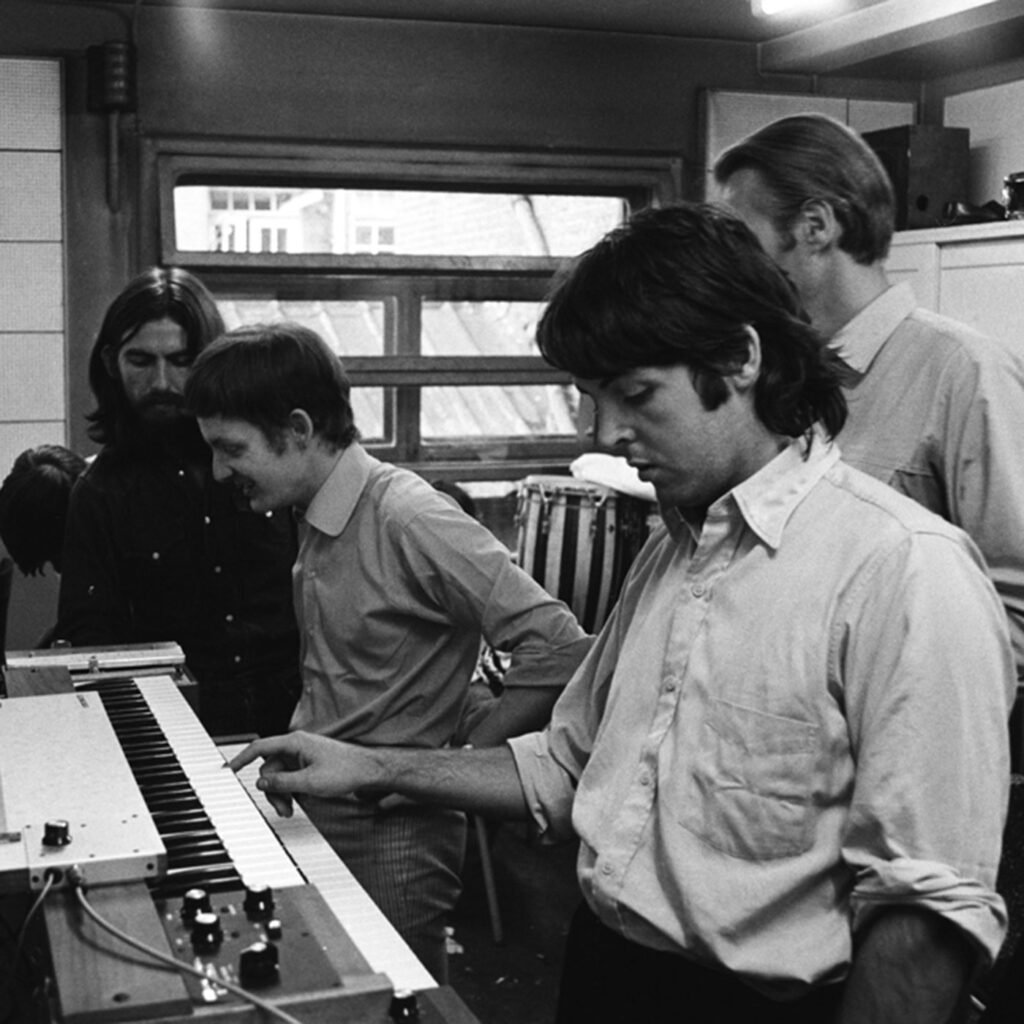
“Abbey Road” is exemplary in demonstrating how track sequencing can enhance the listening experience, weaving individual songs into a coherent narrative and emotional journey. The album begins with the assertive groove of “Come Together,” setting a tone of unity and collaboration that subtly underpins the album. From there, the tracks seamlessly flow, each song complementing or contrasting its predecessor in a way that feels both intentional and natural.
The transition from the optimism of “Here Comes the Sun” to the longing in “Because” exemplifies the album’s adept modulation of mood. Perhaps the most striking feature of “Abbey Road” in terms of track progression is the famous B-side medley. Starting from “You Never Give Me Your Money” through to “The End,” this medley is a masterclass in musical and lyrical storytelling, blending multiple musical themes and lyrical snippets into a cohesive whole. This suite not only showcases The Beatles’ innovative studio techniques but also encapsulates a mini-narrative of departure and reflection, effectively providing the album with a structured conclusion that reflects on its beginning themes.
Thematic Consistency
Throughout “Abbey Road,” The Beatles maintain a remarkable consistency in themes, styles, and emotions, despite the diversity of musical expression present in the album. The thematic elements of love, reflection, closure, and renewal permeate the tracks, whether through direct lyrical statements or more abstract, musical expressions. This thematic throughline is bolstered by the stylistic choices that blend rock, pop, and more avant-garde elements into a singular, unified sound.
Even in its variety, the album avoids jarring shifts, instead offering transitions that serve to enhance the listener’s emotional engagement. For instance, the abrupt end of “She Came in Through the Bathroom Window” followed by the gentle beginning of “Golden Slumbers” contrasts dramatically in style and tone, yet it works within the larger context of the album to highlight the emotional and narrative arcs being explored.
The cohesive quality of “Abbey Road” is also a testament to The Beatles’ and producer George Martin’s meticulous attention to detail in the recording process. Every chord change, every harmony, and every lyrical phrase appears carefully crafted to contribute to the album’s overall impact. The integration of recurring musical motifs and lyrical references across the album fortifies the sense of unity, making “Abbey Road” not just a collection of songs, but a comprehensive artistic statement.
Standout Tracks and Moments

Key Tracks
“Something”: Written by George Harrison, this track is frequently cited as one of the greatest love songs of all time. Its melodic sophistication and emotional resonance set it apart. Harrison’s mature songwriting shines through in the song’s elegant structure and lyrical beauty, underscored by a tender yet profound guitar solo that ranks among the most memorable in rock history.
“Here Comes the Sun”: Another Harrison masterpiece, this song is celebrated for its uplifting melody and optimistic lyrics. It’s a quintessential feel-good track that has transcended its time, offering a sense of hope and renewal. The use of the Moog synthesizer adds a subtle yet innovative layer to the arrangement, enhancing its sunny disposition.
“Come Together”: Starting the album with its funky bass line and enigmatic lyrics, this song is a testament to Lennon’s quirky songwriting. Its driving rhythm and memorable vocal performance make it a standout for its raw, magnetic energy.
The Medley (B-side): The continuous sequence of songs from “You Never Give Me Your Money” to “The End” is a bold and inventive approach, especially at a time when the album format was evolving. This medley is a technical and creative tour de force, showcasing a range of styles and a narrative cohesion that is rare in popular music.
Memorable Moments
The Climactic Guitar Trio in “The End”: Featuring Paul McCartney, George Harrison, and John Lennon each taking turns to play lead guitar, this segment not only highlights their individual talents but also symbolizes their interconnectedness and mutual respect. It’s a powerful instrumental exchange that serves as a fitting metaphor for their collaborative journey.
The Harmonic Convergence in “Because”: The song’s lush, three-part harmony, inspired by Beethoven’s “Moonlight Sonata,” is exquisitely beautiful and showcases The Beatles’ vocal prowess. This track is a sonic testament to the group’s ability to blend classical influences with modern pop sensibilities.
The Opening of “Come Together”: Lennon’s commanding vocal entry over a hypnotic bass line sets the tone for the entire album. It’s a moment that immediately grabs the listener’s attention, combining a groovy beat with enigmatic lyrics that invite countless interpretations.
The Orchestral Crescendo in “Golden Slumbers”: This part of the medley brings an emotional richness, transitioning from a gentle piano introduction to a full orchestral climax. It highlights the dramatic potential of the band’s music and serves as an emotional high point of the album.
These tracks and moments are not only pivotal in defining “Abbey Road”’s place in music history but also illustrate The Beatles’ enduring influence on musical innovation and emotional storytelling in popular music. Each standout track and memorable moment underscores their unparalleled ability to combine profound emotional depth with groundbreaking artistic expression.
Artistic Contribution and Innovation
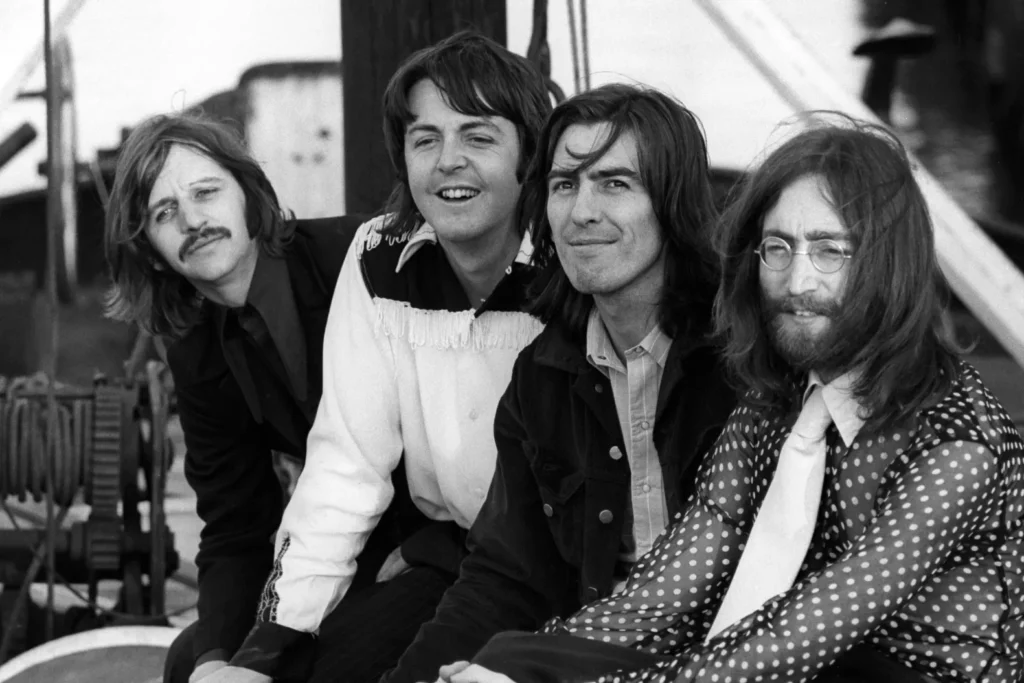
“Abbey Road” not only holds a revered place in rock music but also marks a significant point of innovation within the broader music industry. Released at the close of the 1960s, a decade marked by tumultuous changes in music and culture, this album encapsulates the essence of artistic evolution that The Beatles spearheaded throughout their career. Far from adhering to the established norms of the time, “Abbey Road” pushed boundaries both musically and technically, setting new standards for what could be achieved in a studio setting.
This album came at a time when the rock genre was itself undergoing significant transformation, moving towards more sophisticated and varied sounds. “Abbey Road” embraced these changes, contributing to the genre’s evolution by blending elements of pop, rock, blues, and progressive music with orchestral arrangements and avant-garde influences. Its release solidified The Beatles’ role as pioneers in the industry, continually expanding the horizons of pop and rock music.
Innovation
Advanced Recording Techniques
The album benefited from the use of new technology, including the Moog synthesizer and a solid-state mixing desk, which allowed for clearer and more dynamic recordings. The use of multi-track recording was pushed to new heights on “Abbey Road,” particularly evident in the lush, layered textures found throughout the album. The production techniques employed by George Martin and the band were groundbreaking at the time and have since influenced countless recordings.
Song Structure and Arrangement
“Abbey Road” features some of the most complex and innovative song structures in The Beatles’ catalog. The second side of the album, a nearly continuous medley of several distinct songs, was particularly revolutionary. This approach not only demonstrated a novel way of thematic musical storytelling but also highlighted the band’s ability to craft a cohesive narrative across multiple tracks, blending them into a single, fluid piece.
Thematic Depth
At a deeper level, the themes explored in “Abbey Road” were a departure from much of the popular music of the time. The album delves into introspection, the passage of time, and the acknowledgment of an ending, both in terms of the band’s career and a culturally tumultuous decade. This reflective and mature thematic exploration added a new dimension to rock albums, which often focused more on external experiences rather than internal journeys.
Harmonic and Melodic Innovation
Songs like “Because” showcase complex harmonic structures that drew inspiration from classical music, a rarity in rock music at that time. The sophisticated use of harmony and melody throughout the album set a new bar for musical complexity in popular music.
“Abbey Road” remains a benchmark for innovation in music production, thematic depth, and artistic bravery. Its enduring influence is a testament to The Beatles’ ingenuity and their willingness to explore new creative landscapes, firmly establishing the album as a milestone in the history of music.
Closing Thoughts
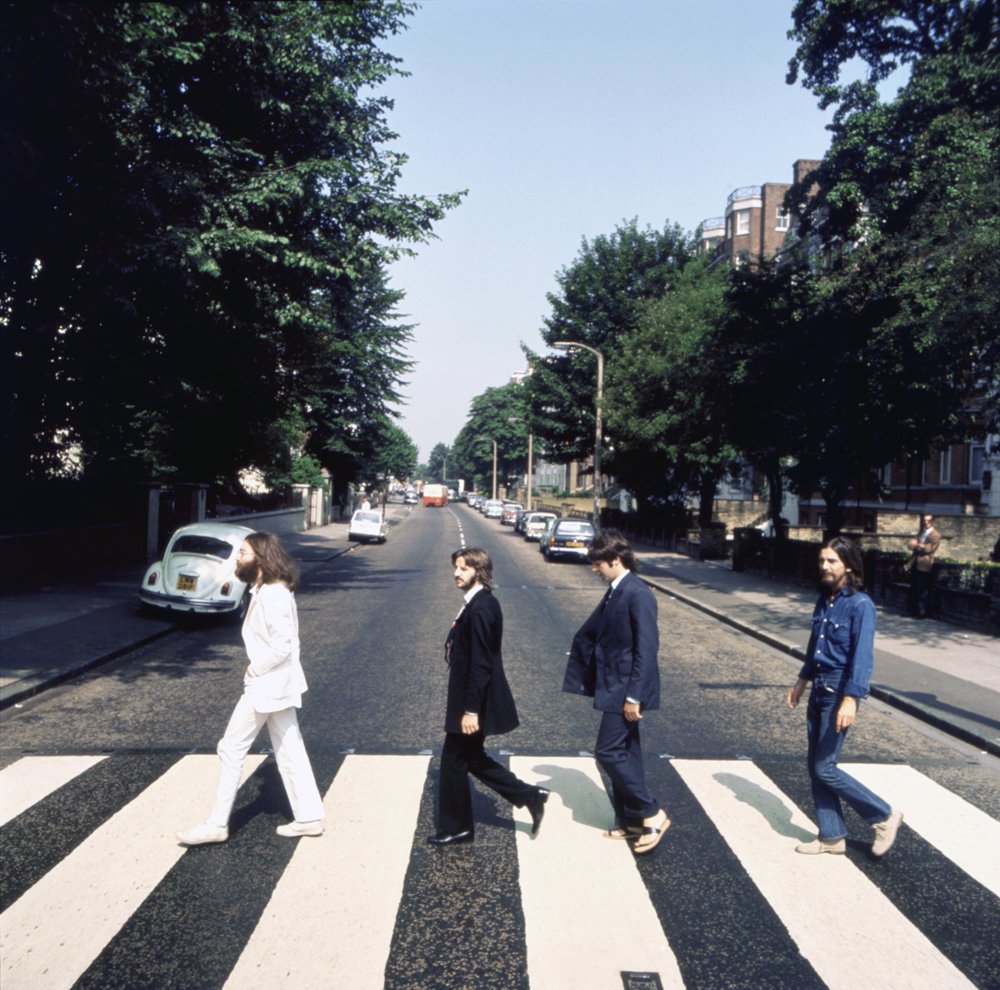
“Abbey Road” is an album that not only encapsulates the culmination of The Beatles’ monumental career but also stands as a defining piece of musical artistry in the 20th century. It highlights the band’s unparalleled ability to blend diverse musical styles into a coherent and emotionally resonant whole, pushing the boundaries of what rock music could represent and achieve.
Strengths
The album’s strengths are numerous and varied, from its sophisticated production and innovative songwriting to its profound thematic depth. The production quality, led by George Martin, is immaculate, making “Abbey Road” one of the best-sounding records of its era and beyond. Musically, the album covers a wide spectrum, from rock and pop to blues and progressive, each style executed with the utmost finesse. The lyrical content is rich, offering reflections on personal and collective experiences that resonate with listeners across generations. Additionally, the seamless flow and cohesion of the album demonstrate a mastery in track sequencing that few other albums have managed to achieve.
Weaknesses
It is challenging to pinpoint weaknesses in an album so widely regarded as a masterpiece. If any, some critics and listeners have noted that the diversity of musical styles and the experimental nature of the B-side medley might not appeal uniformly to all listeners. However, these elements are also what many consider the album’s strengths, showcasing The Beatles’ creative range and willingness to experiment.
Final Thoughts and Rating
“Abbey Road” serves not just as a swan song for The Beatles but as a benchmark in music history, influencing countless artists and bands in how albums could be conceptualized and recorded. Its impact is everlasting, not only in how it resonates emotionally with audiences but also in how it inspires musicians to innovate and push the envelope of their creative expressions.
Given the album’s groundbreaking achievements in production, composition, and thematic exploration, along with its profound impact on the music industry and its enduring legacy, I rate “Abbey Road” a perfect 10 out of 10. This rating reflects its status as a flawless piece of artistry that has not only stood the test of time but has also shaped the trajectory of popular music in profound ways. “Abbey Road” is not just a great Beatles album; it is one of the quintessential albums of all time, offering a timeless journey through complex emotions and innovative music that continues to inspire and captivate listeners around the world.
